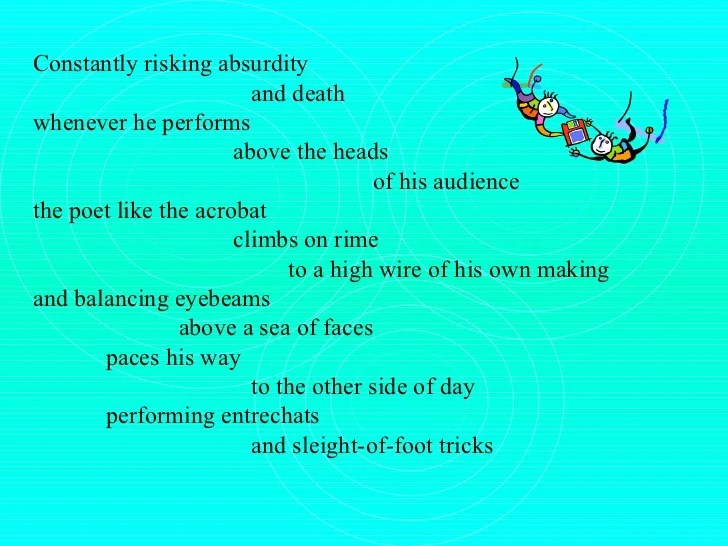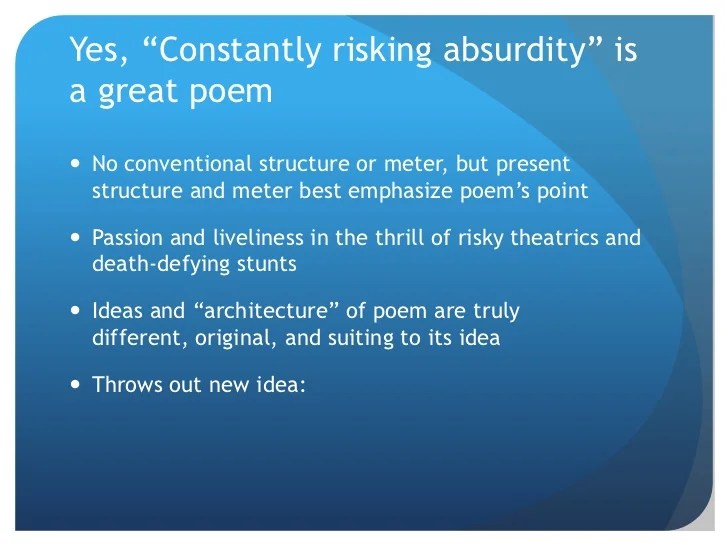Constantly risking absurdity poem analysis – Constantly Risking Absurdity: A Poetic Exploration of Paradox and Risk delves into the complexities of navigating the tension between reason and absurdity, exploring the nature of risk and its relationship to the human condition.
This thought-provoking analysis examines the literary devices employed to convey absurdity, comparing the poem to other works that grapple with similar themes. Prepare to embark on an intellectual journey that challenges conventional thinking and invites contemplation on the nature of existence.
Analyzing the Paradox of “Constantly Risking Absurdity”

The poem “Constantly Risking Absurdity” explores the paradoxical tension between reason and absurdity. The concept of absurdity in literature refers to the inherent meaninglessness or irrationality of existence. In this poem, the speaker navigates this tension by embracing the absurd while simultaneously recognizing its potential pitfalls.
The Speaker’s Navigation of Reason and Absurdity
- The speaker acknowledges the limitations of reason and the inevitability of absurdity.
- They recognize that attempts to find meaning or order in the world often lead to disappointment.
- Despite this, the speaker chooses to engage with the absurd, recognizing its transformative potential.
Examples of Paradoxical States in the Poem
“I am a clown who dances on the edge of a precipice,”
This line illustrates the speaker’s precarious position between reason and absurdity.
“I am a fool who seeks wisdom in the laughter of children,”
Here, the speaker embraces the folly of seeking meaning in the seemingly meaningless.
Exploring the Nature of Risk and Absurdity in the Poem

Types of Risks the Speaker Takes
- Embracing the Unknown:The speaker ventures into uncharted territory, where traditional logic and expectations fail.
- Challenging Conventions:They question established norms and social constructs, embracing alternative perspectives.
- Confronting the Void:The speaker confronts the existential void and the inherent meaninglessness of life.
Contribution of Risks to the Poem’s Themes
- Risks foster a sense of liberation and allow the speaker to transcend societal constraints.
- They reveal the fragility of human reason and the futility of attempts to impose order on chaos.
- Risks ultimately lead to a deeper understanding of the human condition and the acceptance of absurdity.
Relationship between Risk and Absurdity
Risk and absurdity are intertwined in the poem. Taking risks exposes the speaker to the absurd and forces them to confront the inherent meaninglessness of existence. However, it is through this confrontation that they gain a deeper appreciation for the absurdity of life and its transformative power.
Examining the Consequences of Embracing Absurdity: Constantly Risking Absurdity Poem Analysis
Effects on the Speaker’s Perspective, Constantly risking absurdity poem analysis
- Acceptance of Meaninglessness:The speaker recognizes that life is fundamentally meaningless and embraces this absurdity.
- Increased Freedom:By letting go of the need for meaning, the speaker experiences a sense of liberation and freedom.
- Deeper Understanding:Embracing absurdity allows the speaker to see beyond superficiality and gain a more profound understanding of the human condition.
Benefits and Drawbacks of Embracing Absurdity
Benefits
- Liberation from societal expectations
- Enhanced creativity and imagination
- Increased resilience in the face of adversity
Drawbacks
- Potential for nihilism and despair
- Difficulty in communicating with others who do not share the same perspective
- Loss of purpose and direction
Insights into Human Existence
The poem suggests that embracing absurdity is an essential aspect of understanding the human condition. By confronting the void and accepting the meaninglessness of life, individuals can gain a deeper appreciation for the beauty and absurdity of existence.
The Poem’s Use of Language and Imagery to Convey Absurdity

Literary Devices
- Paradox:The poem is filled with paradoxical statements that highlight the tension between reason and absurdity.
- Irony:The speaker uses irony to expose the futility of attempts to find meaning in a meaningless world.
- Symbolism:The clown and the jester are symbols of the absurdity of human existence.
Contribution to the Poem’s Meaning
- These devices create a sense of disorientation and confusion, reflecting the speaker’s own struggle with absurdity.
- They emphasize the irrationality of the world and the futility of trying to impose order on it.
- They evoke a sense of humor and playfulness, suggesting that absurdity can be both liberating and terrifying.
Role of Metaphor, Symbolism, and Irony
- Metaphor:The poem compares life to a circus, highlighting the absurdity of human existence.
- Symbolism:The clown represents the absurdity of human attempts to find meaning in a meaningless world.
- Irony:The poem’s title is ironic, as the speaker’s constant risk-taking is an attempt to escape absurdity.
Comparing the Poem to Other Works that Explore Absurdity

Similar Themes in Other Works
- “The Myth of Sisyphus” by Albert Camus:Explores the absurdity of human existence and the importance of embracing it.
- “Waiting for Godot” by Samuel Beckett:Depicts the futile and absurd nature of human existence.
- “The Stranger” by Albert Camus:Examines the existential crisis of an individual confronted with the meaninglessness of life.
Comparative Approaches to Absurdity
| Work | Approach to Absurdity |
|---|---|
| “Constantly Risking Absurdity” | Embraces absurdity as a transformative and liberating force. |
| “The Myth of Sisyphus” | Presents absurdity as an inescapable condition of human existence that must be confronted. |
| “Waiting for Godot” | Depicts absurdity as a pervasive and oppressive force that traps individuals in a meaningless void. |
Unique Contribution of the Poem
While sharing themes of absurdity with other works, “Constantly Risking Absurdity” offers a unique perspective by emphasizing the transformative power of embracing absurdity. It suggests that absurdity can be a catalyst for liberation and a source of profound understanding of the human condition.
Detailed FAQs
What is the central paradox explored in the poem?
The poem navigates the tension between reason and absurdity, highlighting the paradoxical nature of human existence.
How does the poem convey a sense of absurdity?
The poem employs literary devices such as metaphor, symbolism, and irony to create a sense of absurdity and challenge conventional thinking.
What are the potential benefits of embracing absurdity?
Embracing absurdity can foster creativity, challenge preconceptions, and lead to a deeper understanding of the human condition.
